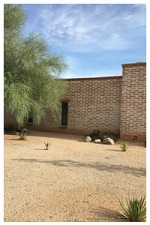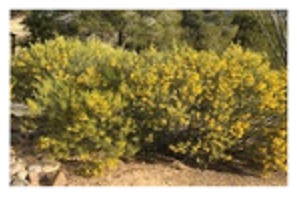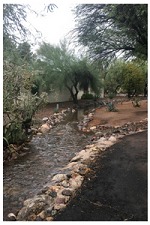Landscaping Guidelines
 Welcome to Desert Gardening (pdf)
Welcome to Desert Gardening (pdf)Colonia Verde is a unique neighborhood in Tucson, in part, because of its cultivation of natural landscaping and smart water usage across the entire community. The CVHOA Landscape Committee is our community steward in ensuring that Colonia Verde continues to thrive in water challenged desert living.
The CVHOA Landscaping Rules and Regulations provides both guidelines and boundaries for homeowners. It describes the role of our landscape committee, the job of our landscape gardeners and suggests homeowner watering schedules throughout the year. Beyond that, here are some things to know about landscaping in CV.
 What to plant
What to plantThere is a list of water-wise plants that can be planted outside your dwelling walls with pre-approval by the Landscape Committee. Inside your walls, the same list of plants is suggested for planting since they are all water-wise. You're not in Kansas (or Wisconsin, Colorado, Virginia, etc.) anymore.
Succulents vs Cacti
Succulents are fleshy, water filled and more delicate than cacti. Colonia Verde is filled with aloe, the most common succulent. Succulents need shade and water. They are more suited to California than Arizona but do well in posts where the moisture can be better controlled. If you see aloe around Colonia Verde that looks brown, with curly, dried leaves, in may need shade and/or water. They are happiest when planted under a tree and watered occasionally.
Cacti are mostly spiny and full of needles. Agave is a type of cactus although confused with aloe, more hardy and larger than aloe. They typically have a sharp needle point at the end of each frond.
 Where to plant
Where to plantMost people think cacti can handle full sun. Actually, they grow naturally under a bush or tree known as a nurse plant. Filtered light under a mesquite tree is the perfect place for a cacti garden. Sun scorching can occur and permanently scar a cactus. They can slowly be acclimated to the sun by covering them in screening for a few weeks. Also, pay attention to the growth direction when purchasing and plant it in the same direction. Most nurseries mark the growth direction of cacti as N or S facing.
When to plant
The best times to plant are in April and May. This misses the late frost/freezes and gives plants time to establish before the heat of summer. Another planting month is October as this misses the heat of summer and gives plants a chance to establish before any chance of a winter freeze (and we do freeze here). We recommend seeking out plants with a cold hardiness to 15 degrees. You will be sorry if you lose your favorite plants to random hard freezes.
Inside your walls
If you have an irrigation system within your walls, please check it regularly for leaks. If you are away, ensure that someone is watching your house for leaks. These can be costly for the entire community! Consider planting desert-wise plants within your walls. The community is watering the plants on your patio via our shared water meters.

Outside your walls
Our goal is to have plants in the common areas that require as close to no water as possible. Watering of new plants is provided if the Landscape Committee chooses to add vegetation to enhance an area. If the area around your home is looking forlorn, contact the Landscape Committee to talk about how to change that.

 Please do not ask the landscape crew to treat the area outside your wall in a special way including complaining when you see shrubbery cut way back. This is done to allow plants to "regrow" naturally which reduces their water demands. The plants are healthier if left natural. The practice of shaping the plants into "balls" increases plants' need for water by encouraging new growth. Here is an example of the same plant, left to grow naturally and sculpted.
Please do not ask the landscape crew to treat the area outside your wall in a special way including complaining when you see shrubbery cut way back. This is done to allow plants to "regrow" naturally which reduces their water demands. The plants are healthier if left natural. The practice of shaping the plants into "balls" increases plants' need for water by encouraging new growth. Here is an example of the same plant, left to grow naturally and sculpted.
We don't encourage homeowner irrigation of common areas. If you have a special concern regarding irrigation in the common areas outside your walls, please submit a Landscape request.
Your eyes are appreciated to point out stressed plants, downed branches and other landscaping concerns. Contact the Landscaping Committee via a Landscape Request.
Watering plants
The landscape crew does not water for you. Their job is to clean and maintain our current landscape. Watering is only provided for new plantings if the Landscape Committee chooses to add vegetation to enhance an area. Once desert plants are established, they will no longer need to be watered.
Manual watering by homeowners should only be done with a spray nozzle that has an on/off trigger. Dragging a running hose wastes water. Don't leave a hose running and walk away - it's too easy to forget the running hose. We all share the water bills in Colonia Verde so wasting water impacts us all. Sprinklers of any type should not be used since evaporation happens quickly in this climate and the water needs to get to the roots, not sprayed across the leaves.
The Landscape Rules and regulations, page 2-3, item 5 has a suggested water schedule for you. This is perfect for a low water use yard. However, it only shows how often, not how much. Watering has to be deep enough to be effective and to promote healthy root growth which in turn prevents a shallow root system and potentially blowing over in a strong wind storm. The amount of water is determined by the size of the container of the plant planted. For low water use plants, a 1 gallon size plant needs 15 gallons a week in warm weather. A 5 gallon size plant needs 20 gallons a week. This goes up in amount if planting from even larger containers. That's a lot of water! Moderate and high water use plants require even more water (which is why we don’t recommend them).
New plantings are an exception to this watering schedule. They should be watered daily for the first week, every other day for a week or two, then every three days for a few weeks. For the rest of the first year, water just once a week. If on a drip system, set the timer for a long enough period to put out enough water determined by the size of the emitter. This information should be available wherever you purchase your equipment. For hand watering, consider your container size.  So, what is Xeriscaping?
So, what is Xeriscaping?
Xeriscaping is the practice of zonal planting and water harvesting for low water use gardening. Channeling the water runoff from your house to plants is important. Low areas often lined with rock and ridges help direct rain water to plants. As Colonia Verde is an older community and this practice is more popular now, we have quite the opposite going on. Most of our water is quickly encouraged away from our houses (and plants) and quickly runs down our streets and washes. This is wasted water.
On a small scale, this can be corrected in each yard on an individual basis by placing mounds and boulders and by digging wells when doing new planting.
An alternative is to take advantage of the CVHOA Rainwater Harvesting program that can capture the water from homes as runoff from our monsoons. Utilizing rain containers can capture and store water for use during our dry times.
Zonal planting is simply the idea of putting more moderate water-use plants in zones against or close to the house and the further out you go, much more arid plants are used. The Landscaping Committee supports and encourages these practices.
Any changes you envision to the areas outside your walls need to be reviewed by the Landscape Committee. The Landscape Committee is happy to talk with you to plan any changes you are considering. Forms are available in the Clubhouse and on our website (Request Forms -> Landscaping Request).
Colonia Verde Resources:
- Approved Colonia Verde Plant List - also available in the Clubhouse
- CVHOA Landscaping Rules & Regulations
- CVHOA Rain Harvesting Program
- Landscaping Request Form - also available in the Clubhouse
- Find your landscaping zone on this map
Additional Resources:
- Arizona Gardener's Guide by Mary Irish
- Landscape Plants for the Arizona Desert from the AZ Municipal Water Users Association
- Local Gardening Centers - B&B Nursery, Mesquite Valley Growers, Harlows, Lowes, Home Depot
- Tucson Lifestyle Magazine, Home and Garden Issue
Pages
- Home
- About Colonia Verde
- Community Calendar
- Property Management Group
- HOA Business
- Board of Directors
- Current Board Minutes
- Previous Board Minutes
- Committee Membership
- Committee Guidelines
- Communications Instructions
- Financial documents
- Archive of Board Minutes
- HOA Rules & Policies
- CVHOA By-laws, CC&Rs
- CVHOA Rules & Policies
- HOA Request Forms
- * HOA Complaint Form
- Architectural Request Form
- Clubhouse Rental Form
- Estate Sale Form
- House Sign
- Landscape Request Form
- Maintenance Request Form
- Resident Directory Update Form
- Resident Guidelines
- Homeowner Summary
- Architecture Guidelines
- Landscaping Guidelines
- Our Shared Water Usage
- About Sewer, Water and Gas lines
- Resident Resources
- Are you a new resident?
- Some Reminders
- Classified Ads
- Colonia Verde Chronicle
- Colonia Verde Maps
- Community Club (CVCC)
- How to Deal with Water Leaks
- Resident Directory by Last Name
- Resident Directory by Street Name
- Useful AZ and Tucson Contacts
- Search the CV HOA website
- Contact form

